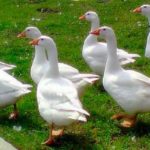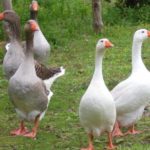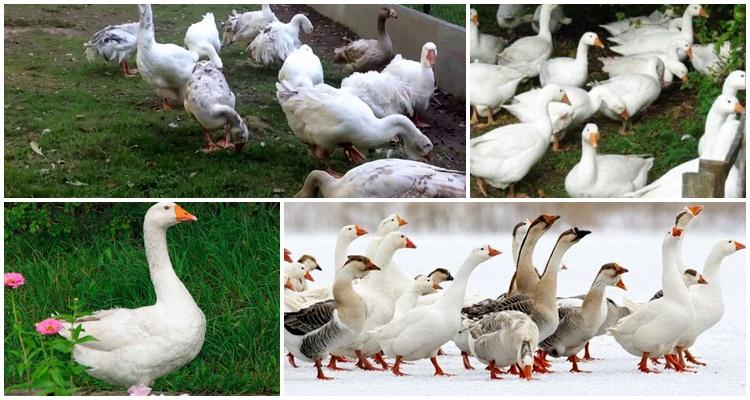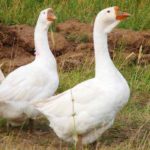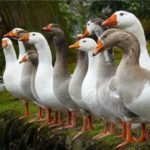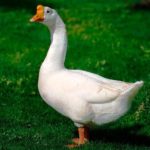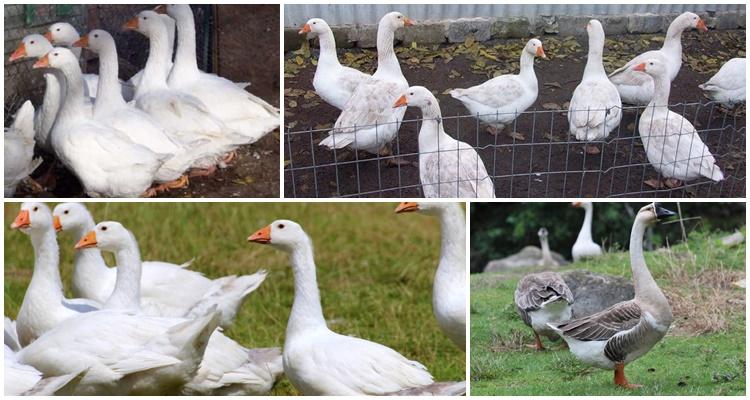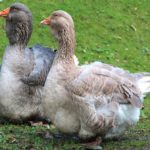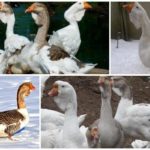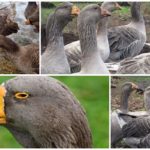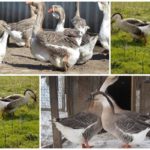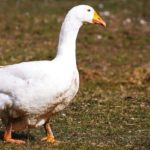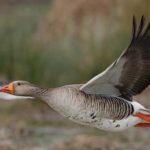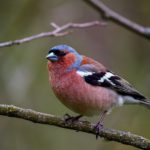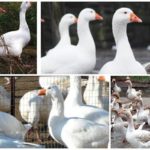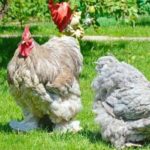In our country, not only domestic breeds of geese, but also promising foreign varieties are successfully raised. They are valued for their excellent productive characteristics. Let's consider the description, advantages and disadvantages of Italian geese, breeding technology, feeding, growing and care conditions. And also, what diseases can Geese get sick and how to treat them their.
History of the breed
The breed of Italian geese was developed in the 20th century. At first they were bred in Italy itself and neighboring countries, but then they began to spread further. They began to be transported to the territory of the Union in 1975. The Italian breed is considered promising; the purpose of breeding is to obtain tender meat and liver, the weight of which is greater than that of birds of other breeds. Italian geese were used to breed new domestic breeds.
Description and main characteristics
The body of Italian geese is compact and horizontal. The neck is short, thick, the head is of medium size. Geese may have a crest and a small fold under the head, but these are not characteristic of the bulk of the breed. The legs and beak are short and orange in color. The feather is white, but sometimes there are patches of gray feathers, which are considered a defect, but acceptable.
Pros and cons of Italian geese
The breed was bred in a warm country, but despite this, the geese were able to adapt to the cold climate of Russia.
Requirements for maintenance and care
Italian geese are mobile and active, staying separate from birds of other breeds. They are aggressive towards strangers, so it is impossible to graze and keep them with other representatives of the bird species.
The rules for keeping and caring for geese of the Italian breed do not differ from the rules regulated for other breeds. They should live in a goose coop, the area of which should be sufficient so that the birds do not feel uncomfortable.PER 1 adult goose of the Italian breed there should be at least 1 sq. m.
But the breed is not suitable for permanent keeping only in a poultry house. Next to it, you need to set up a walking area where you can take the birds out during the day so that they can move actively and breathe fresh air. It is worth releasing even in winter, if it is not cold and there is no wind. Thanks to adaptation to cold climates, geese can tolerate low temperatures. Walking has a positive effect on the health of geese, both physical and mental, and egg production increases.
The rules of care concern maintaining cleanliness in the room where the bird lives and in the walking area. There should be a bedding on the floor that will absorb moisture and droppings. It needs to be changed as soon as it becomes dirty. Suitable materials for bedding include straw, old hay, and dry old peat. It needs to be changed when it gets dirty or twice a year - in spring and autumn. In this case, a thin layer of clean straw is poured over the dirty layer.
Equipment, feeders and drinking bowls must be washed and disinfected, at least by scalding with boiling water. Remains of uneaten food must be removed from them before distributing a new portion.
In the goose barn you need to arrange ventilation, provide lighting, and turn on the lights when the day gets short. This is necessary so that the geese feel comfortable and the geese lay eggs. If there is no additional lighting, the birds will not feel comfortable.
Italian food
The food of Italian geese consists of fresh grass and wet mash. Birds can find grass while grazing, so if there is a meadow nearby, you can graze there. A pond is also suitable - like waterfowl, geese can feed on aquatic vegetation and living creatures.They can find so much food in a pond that they don’t need to be fed at home.
If there is no pasture or pond nearby, Italians need to mow the grass and prepare wet mash from the chaffed grain. Add succulent food - root vegetables and vegetables, vitamins and mineral supplements - salt, chalk, bone and fish meal. Distribute food 2 or 3 times during the day. Feed goslings up to 2 months up to 5 times a day.
In addition to food, geese should always have fresh, clean water. Birds can also be raised on complete poultry feed. The use of ready-made combined mixtures is economically beneficial and convenient. Dry granules are stored for a long time, do not take up as much space as simple feed, birds willingly eat compound feed.
During the period preceding the egg-laying period, geese need to be fed additionally. The majority of the diet should be green grass, and the bird should be given synthetic vitamins a week before laying.
Birds that are fattened for slaughter are fed food that consists half of green and succulent feed, half of grain. It is recommended to boil the grain, so it is better absorbed. On such a nutritious diet, goslings accumulate weight in 2.5 months.
Breeding
Italian geese reach sexual maturity at 8 months. The female lays 4 or 5 dozen eggs. The fertilization rate for the breed is 70-90%; for this you need to create families of 1 gander and 5 geese. To obtain purebred goslings, you need to select only purebred parents. When crossed with other breeds, offspring are obtained that inherit the characteristics of both breeds.
Since Italian geese do not tend to incubate eggs, home incubators are used to hatch goslings.After hatching, the chicks are raised in a brooder. After a month they are transferred to the poultry house.
Diseases and prevention
Geese bred by Italians do not get sick if the maintenance rules are followed. But if the rules are violated, they may suffer from digestive disorders and infections. Infectious diseases can cause significant harm; sick birds not only reduce productivity, but can also die.
Geese cannot be treated without a diagnosis from a veterinarian. Only a doctor can correctly determine the cause of the disorder and prescribe treatment. Antibiotics are used to treat infections. Dietary nutrition is used to treat digestive disorders. To avoid causing gastrointestinal disorders, birds should not be fed old, unfit for consumption or moldy food.
Italian geese are suitable for both industrial and domestic keeping and rearing. These are large, quickly fattening birds. It is not difficult to grow them; they are not demanding either in terms of food or living conditions.

